A Private Tour today in North Norfolk. The plan was to explore some particular sites, looking for birds and other wildlife on the way. It was cool and cloudy, with only a couple of brief signs of the promised brighter intervals, but it stayed dry all day which is always welcome!
To start this morning, we headed up to the heath. A Willow Warbler was singing in the bushes in the car park when we got out of the car. It is not the best time of year to see them, but we had a quick look to see if we could find any Adders first. A Common Lizard was basking on the gravel at the edge of the car park but scuttled away into the grass as we passed. A Brown Silver-line flushed from the side of the path was our first moth of the day.
A single Adder was curled up at the base of the gorse, half hidden in the vegetation, but we got a good look at it before it slithered deeper in. A second Adder a little further along more typically did not even wait before moving off as we approached. They are warmed up now, at this stage of the year, and quick to move when anyone approaches.
As we got back onto the main path, we could hear a Garden Warbler singing in the thick hawthorns at the back to the clearing. A Common Whitethroat was alarm calling ahead of us, before flying up out of the vegetation and disappearing into a bramble patch across the path. There were lots of Linnets in the gorse as we walked out across the heath.

As we walked through a particularly thick patch of gorse, we heard a Dartford Warbler calling. We stopped and looked at the bushes where the sound was coming from and after a minute or so it started to work its way out through the bushes into the heather – we could just see it moving in the vegetation. Then it flew and landed in a smaller gorse bush out in the middle – we could see it was a male Dartford Warbler. Unfortunately it quickly dropped in out of view.
We waited a couple of minutes to see if it might reappear, but the trail seemed to have gone cold. A Nightjar churring briefly from the trees nearby was a bit of a surprise, in the middle of the morning. This particular bird seems to have a habit of day-churring at the moment – we have heard it several times recently here.
Making our way back through the dense gorse, we could hear the Dartford Warbler singing now over the other side. Somehow it had got round behind us! Again, it wasn’t particularly obliging, probably not helped by the cool and cloudy conditions this morning. We saw it fly a couple of times and it perched on the top of the gorse briefly twice, before it dropped down into the thicker stuff. We decided to move on.
The next moth we came across in the grass was a July Belle. This species is probably regular in the right habitat in Norfolk but appears to be under-recorded, so it was a nice one to see today. There were several Silver Y moths flying around too – it seems to be a very good year for this migrant species.
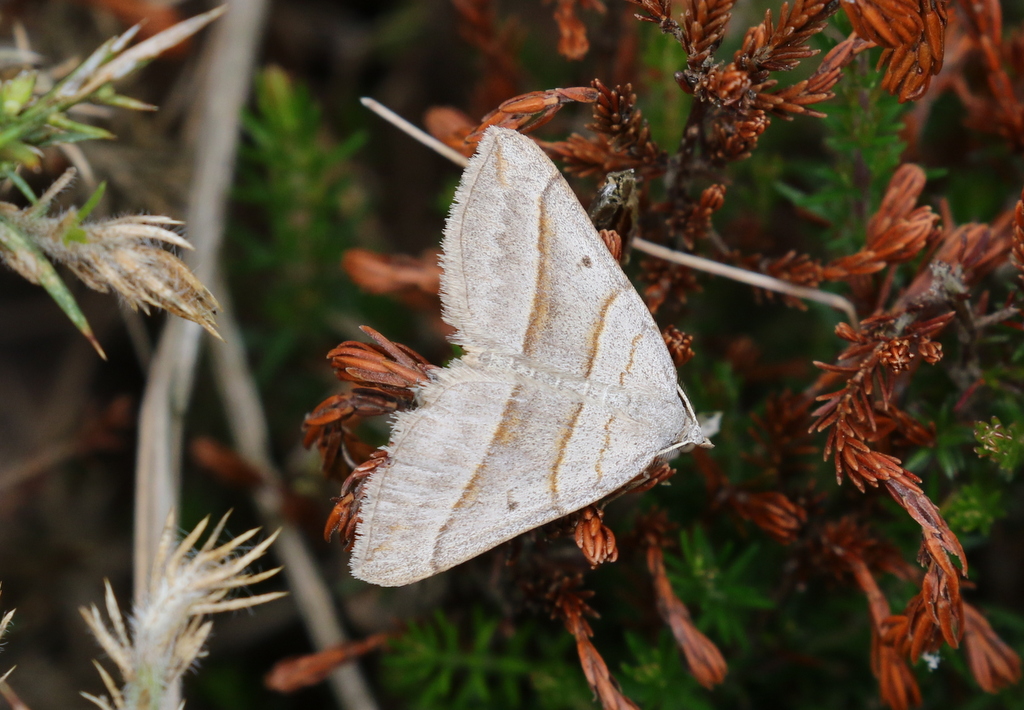
There were several dragonflies up on the heath, despite the cool weather – and the absence of water. A female Broad-bodied Chaser and an Emperor Dragonfly patrolling around the heath were probably not so much of a surprise as an Azure Damselfly which flew up from the grass and landed on a gorse bush.
Many of the birds have already fledged their first broods and we encountered a couple of families on our walk round – a large flock of Long-tailed Tits and a separate flock of Blue Tits. We could hear Coal Tit singing in the trees too. As we walked through a small group of young oaks, we could hear the delicate piping calls of Bullfinches. The smart pink male Bullfinch perched up only briefly before disappearing deeper into the trees.
We went looking for Woodlarks next. There was no sign of any in the first place we looked when we arrived there. A male Yellowhammer was singing from the gorse nearby. We had walked away along the path when we turned to see two Woodlarks dropping in behind us, back where we had just been. We could see their short tails as they flew in. We made our way quickly back but they flew again before we could get a look at them and this time landed down over the bank out of view. We got some more nice flight views as they did, though.
Further down along the path, we heard a Stonechat calling and looked across to see a bright male on a post. It flew to some bushes further back and landed in the very top of one of them. A second bird appeared below, on the edge of the bush, a juvenile Stonechat. The male then dropped down to the ground, caught something, and flew back up to feed the young one.
We heard a Siskin calling and realised it was flying towards us. It landed in the top of a birch tree right in front of us, but we couldn’t really see it in all the leaves before it flew again.
On our way back, the Woodlarks flew up again from beside the path in front of us. This time they landed in a relatively clear area further along and by walking up quietly we were able to approach without disturbing them. We got them in the scope and watched them picking about on the bare earth among the small heather and bramble plants. Lovely views.
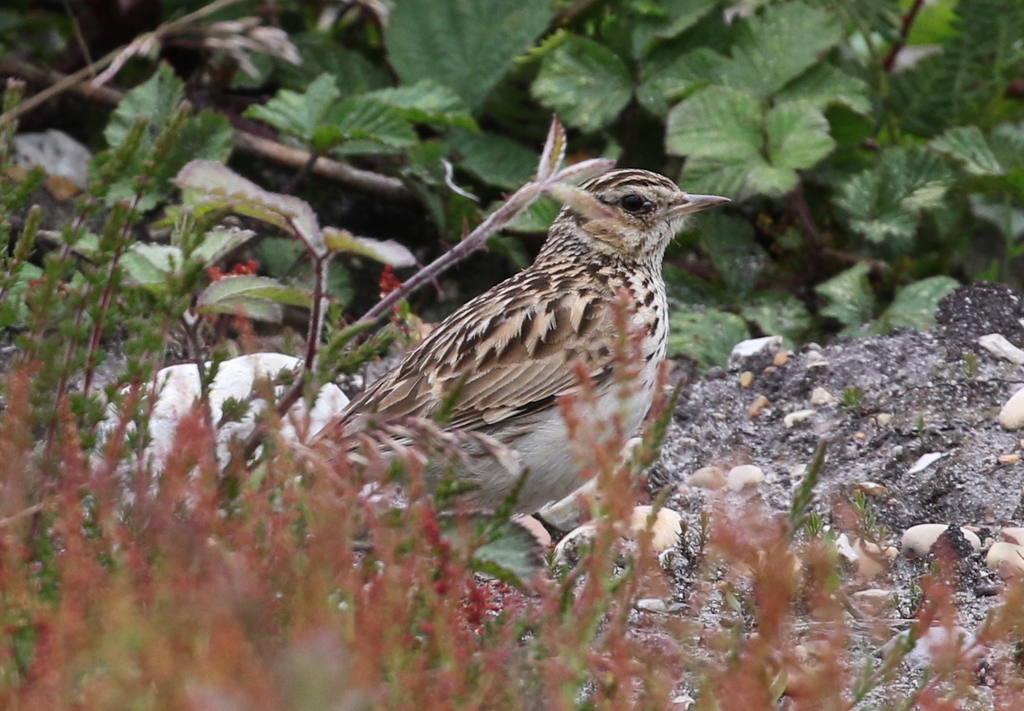
Sometimes it is possible to find Nightjars roosting, and the last week or so we have found a couple of them during the day. So emboldened by hearing one earlier, we headed over to another location where we have seen them before, to try our luck. The first few likely spots we looked, we drew a blank. But perseverance paid off – at the last place we tried, we crept up towards a clump of gorse and peered gingerly over to find a Nightjar looking back at us.
We made sure we kept a good distance away, as Nightjars are very easy to flush from their roost sites. We managed to find an angle where we could just get the scope onto it, and crept up one at a time for a look. The Nightjar was fantastically well camouflaged against the branches and litter below the gorse – what a stunning bird!

We backed off and left the Nightjar in peace. It was getting on for lunch by the time we got back to the car, so we drove down to the coast at Cley and made good use of the facilities at the Visitor Centre.
As we sat eating at the picnic tables in front, we heard a Swallow alarm call and turned to see a Hobby zoom low over the bushes just behind us and out across the reserve. It was going so fast, it managed to get most of the way across Pat’s Pool before anything even noticed it coming! Finally a Lapwing chased it off towards North Scrape.
A Marsh Harrier was flying round in the distance, over Blakeney Freshes. While we were watching it, we heard an Avocet calling behind us, and looked round to see it flying over the car park, an odd place for an Avocet. We quickly worked out why it was there – another Marsh Harrier was quartering the field just behind the Visitor Centre. It was definitely an all action lunch break – there were several Grey Herons and one or two Little Egrets flying backwards and forwards too.
After lunch, we drove along the coast road to Kelling and walked down the lane towards the Water Meadow. We could hear Blackcap and Chiffchaff singing in the hedges on our way. There were more Silver Y moths feeding on the flowers on the verges, along with one or two Speckled Wood butterflies. A Painted Lady flew up from basking on the path and landed on the brambles briefly. We also flushed a Black-tailed Skimmer from the bushes as we passed.
The Water Meadow itself help a selection of typical birds. A Lapwing flew up from the margin calling and a couple of Avocet were busy feeding on the pool. There were several Shelduck, a pair of Gadwall and a few Mallard on the water. A Sand Martin swooped down for a drink.
There were a couple of Common Whitethroats singing in the brambles by the path alongside the Water Meadow and, when we got down to the corner, we heard a brief snatch of Lesser Whitethroat rattle song too, in the dense blackthorn. A Reed Bunting was more obliging – singing in the reeds by the path and letting us pass by within just a few feet.
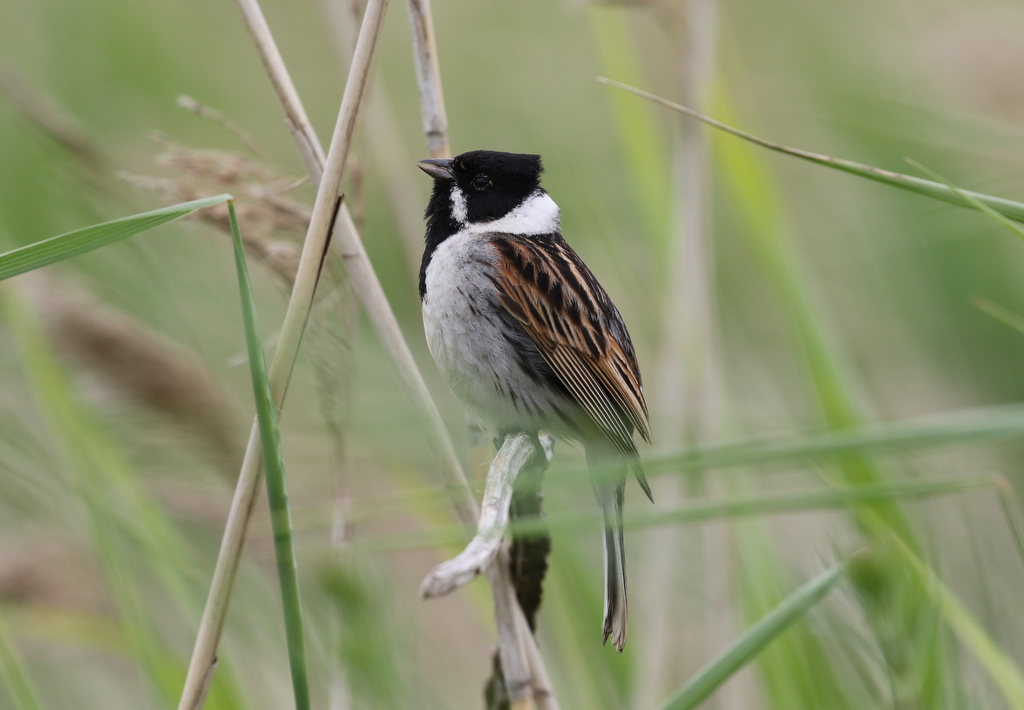
There were more Linnets in the bushes as we took the permissive path up the hill from the Quag. We stopped to watch a Meadow Pipit displaying, fluttering up chipping before the song gradually accelerated and it parachuted back down again. A flash of white past us was a Wheatear, which landed briefly in the bushes down by the beach before being chased off its perch by one of the Linnets and disappearing down into the grass behind. It is getting late now for a northbound spring migrant – perhaps some birds might oversummer here this year, given the weather.
A quick look out to sea produced a single Fulmar flying past and a Sandwich Tern offshore. There was a nice display of Southern Marsh Orchid in flower on the edge of the Camp, so we decided to have a quick look to see if any Bee Orchid were out yet. We couldn’t find any – the verge is a bit overgrown here these days, but it is probably also early here, given how exposed the site is.
On our way back down, a Red Kite was circling over the fields the other side of the Quags, where the grass was being harvested for silage. There were a couple of Skylarks singing on the edge of the Camp, and a family of Pied Wagtails was feeding around the gun emplacements. A Meadow Pipit posed nicely on a fence post by the path.

Our final destination for the day was Stiffkey Fen. As we got out of the car, the first thing which struck us was the fantastic display of Poppies in the meadow opposite. We went over for a closer look – and some obligatory photos!

There are some nice hedges by the path here and some sheltered areas out of the wind, which meant for a nice selection of insects as we walked along. First, we flushed an Orange Tip from the edge of the path. Then we stopped to admire several bee mimic hoverflies, Volucella bombylans, in the brambles. They look very like bumblebees and are variable in appearance as they even mimic different species of bee! There were a couple of different moths in the vegetation along the path here too, Silver-ground Carpet and Straw Dot.
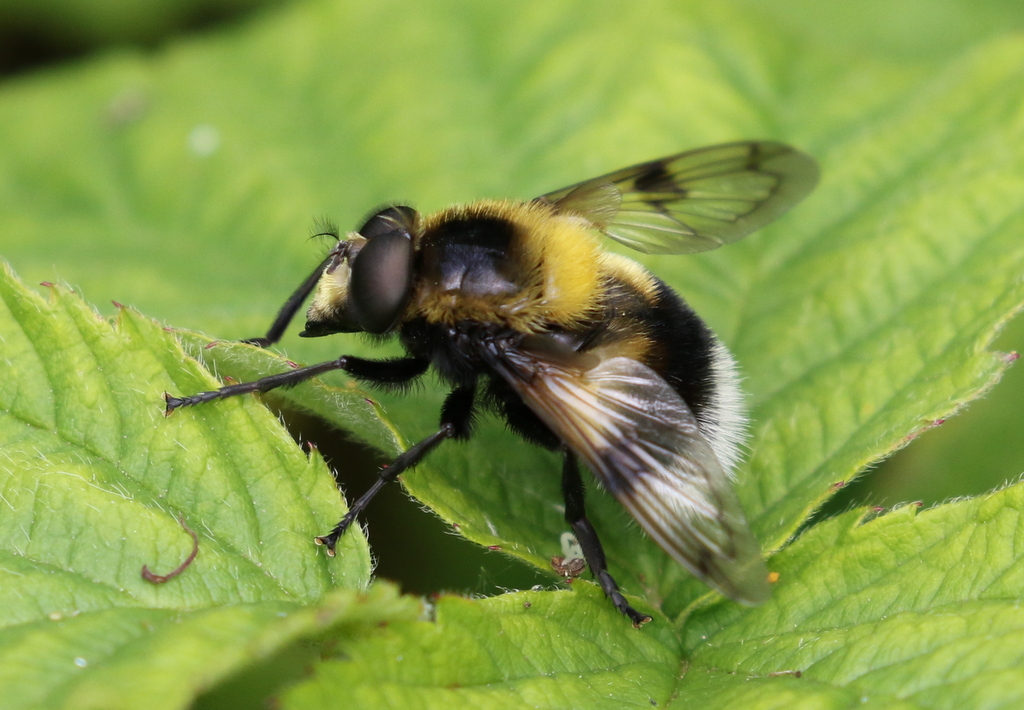
When we got to the gap in the trees where you can see over the brambles to the Fen, the first thing we noticed was a large white bird on one of the islands. It was a Spoonbill, and it was doing what Spoonbills like to do best. Sleeping!

Up onto seawall, we had a better view across the whole of the Fen. We had a look at the Spoonbill in the scope, noting its rather sparse bushy crest blowing in the wind – possibly a sub-adult bird. When it took off, we thought it might fly up past us and out towards the harbour to feed, but instead it just landed straight back down again behind the reeds, where we couldn’t see it. There were lots of Avocets on the Fen, including several small juveniles. We found one Little Ringed Plover too, on one of the islands.
Making our way round to the harbour, a Reed Warbler and a Common Whitethroat were feeding in the dense vegetation just below us, on the seawall. The Reed Warbler was singing rather half-heartedly. A gang of eight noisy Oystercatchers chased each over round overhead.
Out in the harbour, the tide was about half way out. A large mob of teenage Mute Swans were swimming in the channel. Mute Swans take several years to mature and there appeared to be several different ages here, based on the colour of their bills. A group of Dunlin and Ringed Plovers were feeding further out, on the mud. We could see all the seals in the distance out on Blakeney Point.
As we turned to walk back, a male Marsh Harrier flew past just behind the hedge and helpfully came up into view. A Common Tern flew past along the harbour channel. Back at the Fen, the Spoonbill was still asleep. A Speckled Wood posed nicely in the brambles along the footpath back towards the road.
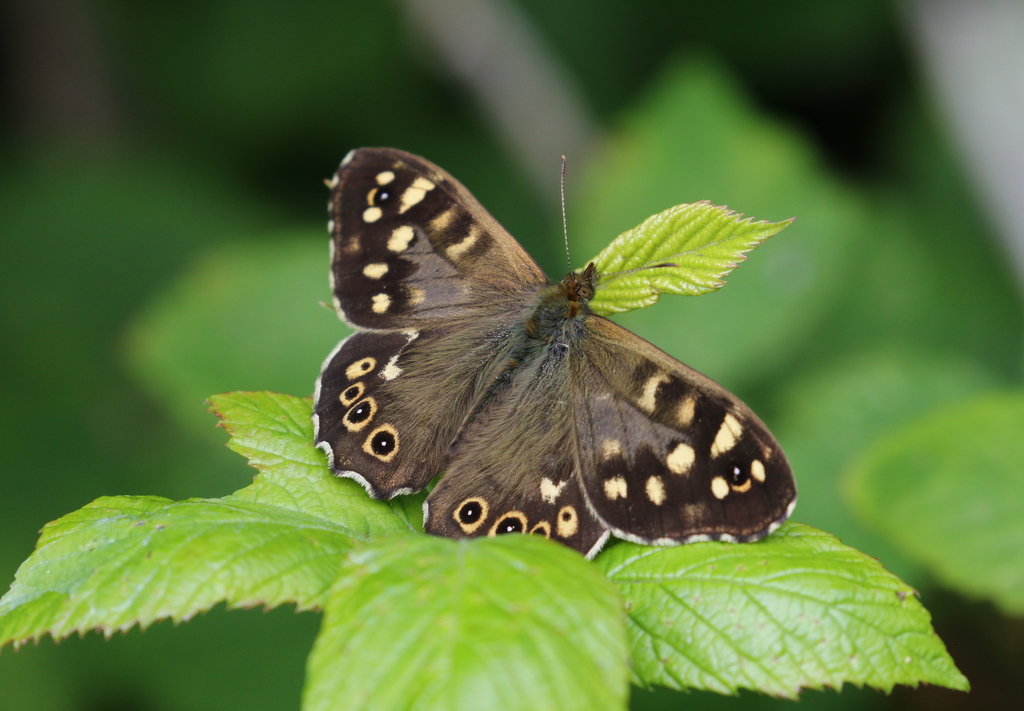
It was time to head for home now. It had been a very interesting day out – some new sites for the group, and lots of interesting wildlife, not just birds today.
















